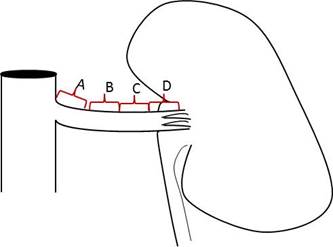Classification of Fibromuscular Dysplasia in Kidney Donors Based on Severity and Extent of Lesion.
Mayo Clinic, Rocheste
Meeting: 2017 American Transplant Congress
Abstract number: B170.1
Keywords: Donation, Renal artery stenosis
Session Information
Session Name: Poster Session B: Kidney Complications II
Session Type: Poster Session
Date: Sunday, April 30, 2017
Session Time: 6:00pm-7:00pm
 Presentation Time: 6:00pm-7:00pm
Presentation Time: 6:00pm-7:00pm
Location: Hall D1
Introduction: Selection of living kidney donors (LKD) with renal artery (RA) fibromuscular dysplasia (FMD) is controversial, as traditional diagnostic classifications lack estimates on FMD severity. We conducted a retrospective analysis of LKD with incidental FMD and proposed a radiological classification based on occlusive severity, extent of vessel involved and the presence of aneurysm.
Methods: Retrospective review of medical records of potential LKD and computerized tomographic angiogram was done at our center from January 2000 to August 2015. A classification was established to assess severity and location of FMD. “Extent” was defined as the sum of identified segments involved. Suitability for donation was based on surgical and medical judgment regarding outcome of donor and recipient, in addition to conventional donor selection criteria.
| Grade | Severity | Description |
| 1 | Mild | Minimal contour change, subtle webbing (<20% alteration in diameter of renal artery) |
| 2 | Moderate | Beaded segment of renal artery, 20-50% alteration in the diameter without dilatation/aneurysmal changes (<20% expansion of renal artery) |
| 3 | Severe | Extensive alteration of renal artery >50% and tortuosity without aneurysmal changes |
| 4 | Aneurysmal | >10mm dilatation of renal artery |
 Results: Of 3327 potential LKD, 98 (2.9 %) had incidental FMD, and 38 donated a kidney. Accepted FMD donors had less severe FMD (Grade 1.3±0.1 vs. 1.9±0.2 p<0.01), and minimal aneurysms, although “extent” of FMD did not differ. Systolic blood pressure 119±15 vs.128±16 mmHg p=0.02 was lower in accepted donors. Urine protein excretion rate and albumin did not differ. Accepted LKD with FMD did not differ regarding age, gender, race, BMI and renal function by iothalamate clearance.
Results: Of 3327 potential LKD, 98 (2.9 %) had incidental FMD, and 38 donated a kidney. Accepted FMD donors had less severe FMD (Grade 1.3±0.1 vs. 1.9±0.2 p<0.01), and minimal aneurysms, although “extent” of FMD did not differ. Systolic blood pressure 119±15 vs.128±16 mmHg p=0.02 was lower in accepted donors. Urine protein excretion rate and albumin did not differ. Accepted LKD with FMD did not differ regarding age, gender, race, BMI and renal function by iothalamate clearance.
Conclusion: Potential LKD with incidental FMD vary substantially with regards to severity and extent of disease. Here we propose an FMD classification to guide donor evaluation and future research. These data suggest a framework for evaluating allograft and donor outcomes based on measurable indices of FMD severity may.
CITATION INFORMATION: Gonzalez Suarez M, Amer H, Jaffer I, Vrtiska T, Rule A, Prieto M, Textor S. Classification of Fibromuscular Dysplasia in Kidney Donors Based on Severity and Extent of Lesion. Am J Transplant. 2017;17 (suppl 3).
To cite this abstract in AMA style:
Suarez MGonzalez, Amer H, Jaffer I, Vrtiska T, Rule A, Prieto M, Textor S. Classification of Fibromuscular Dysplasia in Kidney Donors Based on Severity and Extent of Lesion. [abstract]. Am J Transplant. 2017; 17 (suppl 3). https://atcmeetingabstracts.com/abstract/classification-of-fibromuscular-dysplasia-in-kidney-donors-based-on-severity-and-extent-of-lesion/. Accessed December 12, 2025.« Back to 2017 American Transplant Congress
